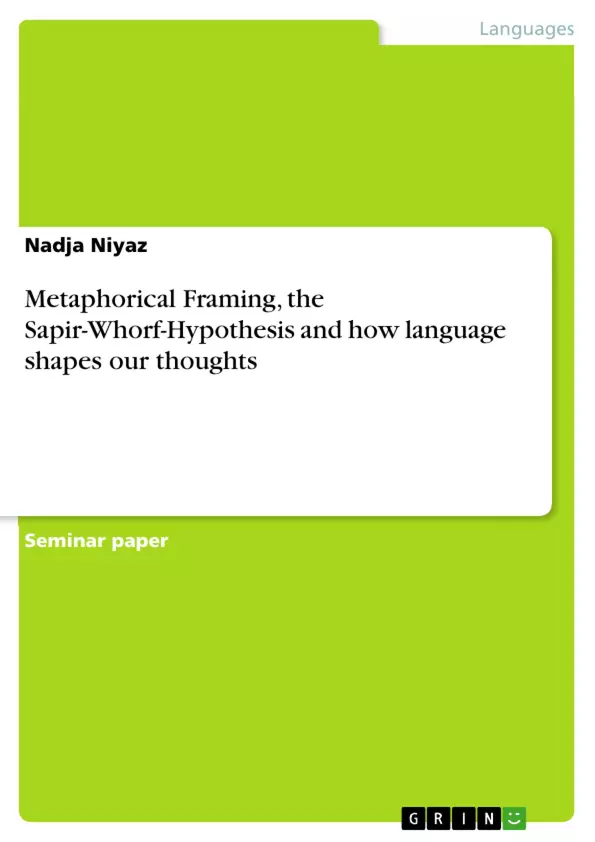In this paper I will first explain what the term Metaphor means and highlight the claim, that it is not only a poetic device, but that conceptual metaphors are pervasive in our everyday life and have a brief look at the Sapir-Whorf-Hypothesis. In the second part I will explain in detail what Metaphorical Framing is, how it works and what the pros and cons of Metaphorical Framing are. To that end I am going to include two series of experiments concerning metaphorical framing of crime and climate change from Thibodeau and Boroditsky and Wolsko et al. giving a short overview about their findings.
Throughout time the metaphor has always been an object of interest and one of the reasons might be, that our mind “is a connecting organ, it works only by connecting and it can connect any two things in an indefinitely large number of different ways” (Charteris-Black 2014). So, as Lakoff and Johnson argue, metaphors are eminent in our brains, the way our conceptual system and therefore our mind works, how we think, argue, and reason. And exactly because of that, our brain can also be manipulated by metaphor. It is not only a linguistic concept, but an important influence on how we think and behave.
Headlines like “Why won’t the world tackle the refugee crisis?” or “Two summits this week will try to address the 65 million displaced and 20 million in danger. But they are under fire before talks have even begun” (McVeigh and Townsend), seem to be ‘normal’ to us, when indeed they are heavily loaded with negative connotations and war metaphors. This use of metaphors to influence people’s way of thinking is called metaphorical framing.
Inhaltsverzeichnis (Table of Contents)
- Introduction
- Metaphor and the Sapir-Whorf-Hypothesis
- Traditional views on metaphor
- Conceptual Metaphor
- Sapir-Whorf-Hypothesis
- Metaphorical Framing
- What is Metaphorical Framing?
- How does Metaphorical Framing work?
- Positive and negative sides of Metaphorical Framing
- Conclusion
Zielsetzung und Themenschwerpunkte (Objectives and Key Themes)
This paper examines the concept of metaphorical framing and its influence on human thought and behavior. The author aims to explain the nature of metaphor, explore the Sapir-Whorf-Hypothesis, and delve into the mechanisms and consequences of metaphorical framing.
- The pervasiveness of metaphors in human thought and language.
- The Sapir-Whorf-Hypothesis and its implications for language and cognition.
- The definition, mechanisms, and effects of metaphorical framing.
- The influence of metaphorical framing on perception and decision-making.
- The potential benefits and drawbacks of metaphorical framing.
Zusammenfassung der Kapitel (Chapter Summaries)
- Introduction: This chapter introduces the concept of metaphor as a fundamental element of human cognition and communication. It highlights the role of metaphors in shaping our understanding of the world and influencing our actions. The chapter also introduces the notion of metaphorical framing as a technique for influencing thought and behavior.
- Metaphor and the Sapir-Whorf-Hypothesis: This chapter explores the historical and theoretical foundations of metaphor. It discusses traditional views of metaphor as a literary device and introduces the concept of conceptual metaphors as pervasive elements of human thought. The chapter also provides a brief overview of the Sapir-Whorf-Hypothesis, which posits a relationship between language and thought.
- Metaphorical Framing: This chapter delves into the concept of metaphorical framing, defining it as a technique for influencing perception and decision-making through the use of metaphors. It discusses the mechanisms by which metaphorical framing operates, exploring the psychological processes involved in metaphor comprehension and interpretation. The chapter also examines the potential positive and negative consequences of metaphorical framing, drawing on research on the framing of crime and climate change.
Schlüsselwörter (Keywords)
This paper focuses on the concepts of metaphor, conceptual metaphor, metaphorical framing, the Sapir-Whorf-Hypothesis, cognitive models, and the influence of language on thought and behavior. It explores the ways in which metaphors shape our understanding of the world and influence our decision-making processes.
- Quote paper
- Nadja Niyaz (Author), 2017, Metaphorical Framing, the Sapir-Whorf-Hypothesis and how language shapes our thoughts, Munich, GRIN Verlag, https://www.grin.com/document/369108



